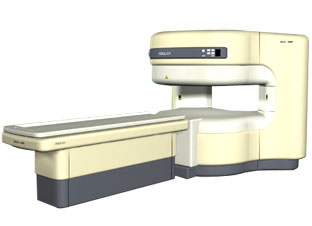 | Info
Sheets |
| | | | | | | | | | | | | | | | | | | | | | | | |
 | Out-
side |
| | | | |
|
| | | | | |  | Searchterm 'SPIR' was also found in the following services: | | | | |
|  |  |
| |
|
Types of oral contrast agents with positive signal enhancement:
Ideal oral contrast agents are immiscible with water, biologically inert, have a low viscosity and surface tension. Oral positive contrast agents may improve the separation of bowel loops, the detection of polyps in colon MRI or the assessment of inflammatory bowel in the small intestine.
Several positive oral contrast agents are available and they are safe to use, for example gadolinium solution, ferric ammonium citrate, different oil emulsions and pediatric formula.
Unfavorably motion artifacts caused by re spiration and peristalsis may be increased in MR imaging. In addition, the signal of the positive contrast medium may decrease caused by dilution in gastrointestinal (GI) secretions. With the use of contrast agents that are immiscible with water, no dilution and accompanying signal loss occur even when the contrast agent is in contact with the intraluminal contents of the GI tract.
Another disadvantage may be residual substances in the bowel, resembling masses when enclosed by bright signal. In addition, positive contrast agents may have a similar signal as bright masses, which make their (e.g. lipoma) detection difficult.
See also Gastrointestinal Paramagnetic Contrast Agents, Combination Oral Contrast Agents, Gastrointestinal Diamagnetic Contrast Agents. | | | |  | | | |  Further Reading: Further Reading: | Basics:
|
|
| |
|  | |  |  |  |
| |
|

From ISOL Technology
'RELAX is open type MRI system created by making up for the weakness of existing conventional MR systems and applying the strength and the application of the middle to high field MR without uncompromising the image quality.
RELAX offers you a premium mix of form, performance and functionality that are patient and user
friendly beyond comparison.
- New breed of MRI pursuing
- patients comfort'
Device Information and Specification CLINICAL APPLICATION Whole body lower than 2.4 m from the iso-center | |  | |
• View the DATABASE results for 'RELAX 0.35T™' (2).
| | | | |
|  | |  |  |  |
| |
|
Liver imaging with gadolinium contrast enhanced MRI is sometimes not sufficient for a reliable diagnosis of liver lesions.
For this reasons, special liver Contrast agents that are targeted to the reticuloendothelial system (RES), have been developed to improve both detection and characterization of liver and spleen lesions. Reticuloendothelial Contrast Agents, as e.g. superparamagnetic iron oxides ( SPIO), are taken up by healthy liver tissue but not tumors.
These RES targeted contrast agents provide a prolonged imaging window and enough time for high spatial resolution or multiple breath hold images. Reticuloendothelial contrast agents have an increased sensitivity for the detection of small liver lesions (e.g., metastases), compared with gadolinium enhanced MRI and spiral CT. At higher field strengths with an increased signal to noise ratio the susceptibility effect with iron oxide particles may be enhanced.
Other new agents ( Gadobenate Dimeglumine, Gadoxetic Acid) have both an initial extracellular circulation and a delayed liver-specific uptake. Since a considerable part of these contrast agents is excreted in the bile, functional biliary imaging can diagnose biliary anomalies, postoperative bile leaks, and anastomotic strictures. Other agents, such as liposomes (with encapsulated Gd-DTPA) or DOTA complexes are in different development stages.
See also Hepatobiliary Contrast Agents, Gadolinium Oxide, Superparamagnetic Iron Oxide and Liposomes. | |  | |
• View the DATABASE results for 'Reticuloendothelial Contrast Agents' (3).
| | | | |
|  |  | Searchterm 'SPIR' was also found in the following services: | | | | |
|  | |  | |  |  |  |
| |
|
In MR, saturation is a nonequilibrium state with no net magnetization. The same amount of nuclear spins is aligned against and with the magnetic field. Saturation methods like FatSat, SPIR etc., work with a frequency selective saturation pulse for a specific chemical shift applied before the actual sequence starts. This saturation pulse adjusts the magnetization from tissue components to zero. The hydrogen nuclei of fat and water resonate at different frequencies, which makes it possible to excite just the fat with repeatedly applying RF pulses at the Larmor frequency with interpulse times compared to T1. The resulting signal is then destroyed with a gradient pulse ( Spoiler Gradient Pulse). Fat is the chemical compound to be saturated at a fat saturation sequence. When the actual sequence follows, (e.g., a spin echo sequence) the unwanted suppressed component will not resonate.
See also Saturation Recovery. | |  | |
• View the DATABASE results for 'Saturation' (54).
| | | | |
|  | |  |  |
|  | |
|  | | |
|
| |
 | Look
Ups |
| |